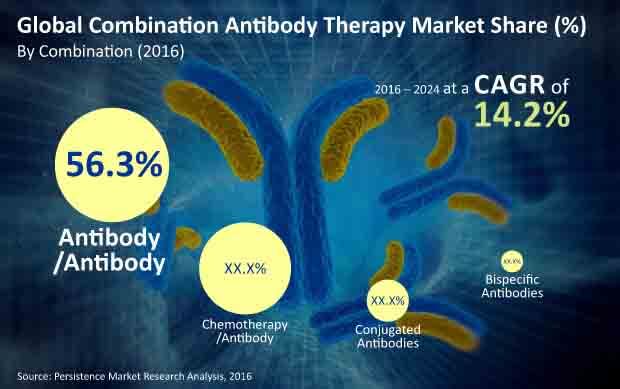Combination Antibody Therapy Market Segmented By Chemotherapy/Antibody, Antibody/Antibody, Conjugated Antibodies, Bispecific Antibodies combination for Lung Cancer, Blood Cancer, Breast Cancer, Colorectal Cancer
Industry: Healthcare
Published Date: January-2017
Format: PPT*, PDF, EXCEL
Delivery Timelines: Contact Sales
Number of Pages: 234
Report ID: PMRREP11740
According to the report, revenue contribution of the chemotherapy/antibody segment to the global combination antibody therapy market was estimated to be close to 40% market share by 2016 end. The chemotherapy/antibody segment is anticipated to exhibit a CAGR of 7.8% in terms of value over the assessed period. This segment is estimated to be valued close to US$ 35 Bn by 2024.
The first and foremost reason for fueling the growth of the chemotherapy/antibody segment is the rise in the rates of cancer across the globe. Cancer is the second leading cause of death globally after cardiovascular drug for disease. The proportion of deaths around the world due to cancer has increased remarkably in the last few years. According to the World Health Organization (WHO), cancer accounts for more than 8 million deaths each year, with about 70% new cancer cases expected to be reported over the next 20 years.
Each cancer type requires a unique treatment and chemotherapy is one of them. Hence, increasing prevalence of cancer and the need for chemotherapy that is capable of attacking cancer cells throughout the body is driving the growth of the chemotherapy/antibody segment of the global combination antibody therapy market.
Another factor which is creating robust development in the chemotherapy/antibody segment is that combination antibody therapies are more effective than traditional therapies such as radiation or surgery. Radiation therapy and surgery can remove, damage or kill cancer cells in a particular area; however, combination antibody therapy such as chemotherapy/antibody can work throughout the body.
The effectiveness of combination antibody therapy is creating a positive impact on the chemotherapy/antibody segment. An increasing awareness regarding the treatment options for cancer among people is also fueling the growth of the chemotherapy/antibody segment.
The chemotherapy/antibody segment in the North America region was estimated to be valued at US$ 8,851.1 Mn by 2016 end and is expected to reach US$ 13,951.3 Mn by 2024. The chemotherapy/antibody segment in the North America combination antibody therapy market is expected to increase 1.6X in terms of revenue during the forecast period.
While in Latin America and APAC regions the market share of the chemotherapy/antibody segment is more than 40%. In the APAC region, the chemotherapy/antibody segment was estimated to be valued at more than US$ 2,000 Mn by 2016 end and is expected to reach close to US$ 6000 Mn by 2024. The chemotherapy/antibody segment in the APAC combination antibody therapy market is expected to increase 2.1X in terms of revenue during the forecast period.

In 2008, U.S. based company Biogen Inc. announced the successful phase III clinical trials of Rituxan. In combination with chemotherapy, this drug helped improve progression free survival in patients with relapsed chronic Lymphocytic Leukemia. In 2010, the FDA approved Rituxan in combination with chemotherapy drugs such as fladarabinie and cyclophosphamide (FC) for the treatment of the most common type of Adult Leukemia.
The top 10 key players operating in the global combination antibody therapy market collectively contribute approximately 80% revenue share to the global combination antibody therapy market. The remaining players contribute approximately 20% revenue share to the global combination antibody therapy market.
|
By combination, the market is segmented into: |
|
|
By application, the market is segmented into: |
|
|
By end user, the market is segmented into: |
|
|
By region, the market is segmented into: |
|
To know more about delivery timeline for this report Contact Sales
